Japan
Wood Products Prices
Dollar Exchange Rates of 25th
November
2018
Japan Yen 113.781
Reports From Japan
¡¡
Trade tensions a risk to
growth
Japan¡¯s Cabinet Office in its November Economic Report
has maintained its assessment that the economy "is
recovering at a moderate pace" citing positive private
consumption and capital spending despite weakening
exports in the third quarter. However, it does warn
heightened trade tensions are a risk to growth.
The November report says:" Attention should be given to
risks including the effects of situations concerning trade
issues on the world economy, the uncertainty in overseas
economies and the effects of fluctuations in financial and
capital markets."
See:
http://www5.cao.go.jp/keizai3/getsurei-e/2018nov.html
In contrast to the Economic Report the OECD has
downgraded its growth projections for Japan in 2018 from
1.2% to 0.9% and in 2019 from 1.2% to 1.0% as there is
likely to be a negative response to the October 2019
consumption tax increase.
Fragile consumer sentiment
The latest consumer confidence indices based on a survey
by the Cabinet Office points to growing a growing sense
of pessimism amongst consumers with the main October
sentiment indices dropping from a month earlier.
Concern is growing that if this persists then the rise in
consumption tax scheduled for late 2019 could seriously
undermine the advances the economy has made in 2018.
When the consumption tax was raised in 2014 domestic
demand collapse and caused the economy to fall into
recession.
The government is eager to avoid a repeat of and has
outlined measures it hopes will support consumer
spending after next year¡¯s consumption tax increase
promising ¡°extraordinary measures¡± to stabilise private
consumption.
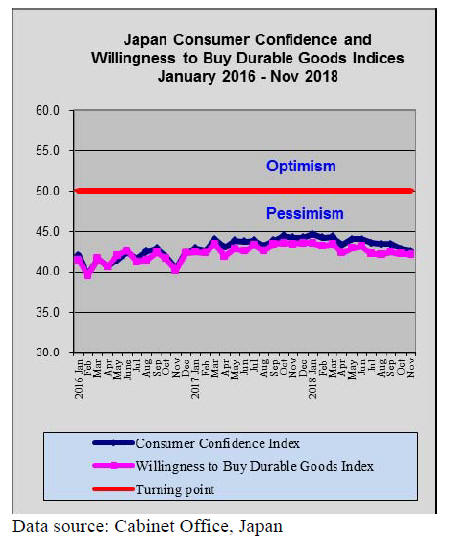
Be prepared for a stronger yen
As a result of a slowing of growth in the US, coupled with
heightened uncertainty in the global trading system,
analysts are forecasting money will again move to the Yen
as a safe haven and that this could drive the yen to as high
as 108/110 to the dollar.
For most of this year the yen has weakened against the US
dollar but this is likely to change with the yen possibly
tipping to below 110 to the US dollar in the medium term.
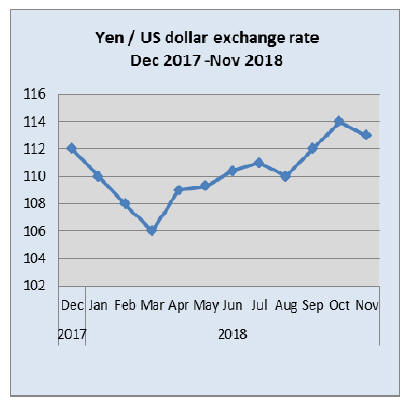
No spark in housing market
The latest housing statistics from the Ministry of Land,
Infrastructure, Transport and Tourism portray a steady but
stagnant demand. October 2018 starts were a mirror of
those in October 2017 and month on month there was
virtually no change.
After the surprising crash in housing starts in March this
year demand recovered such that between May and July
there was a steady increase in building activity. However,
this growth was not maintained into the third quarter of the
year. Prospects for a recovery in the final quarter are dim
as winter weather disrupts building work.

Import round up
Doors
Third quarter 2018 wooden door imports
Japan¡¯s wooden door imports tend to tail-off in the third
quarter (September 2017 was an anomaly) of each year
only to rise again towards year end and this pattern is
emerging for 2018.
Third quarter 2018 wooden door imports were down 6%
compared to the same quarter in 2017 and year on year
September imports were also down 11%.
The 7% decline in imports in September compared to a
month earlier follows a pattern seen in earlier years such
that a rebound can be expected.
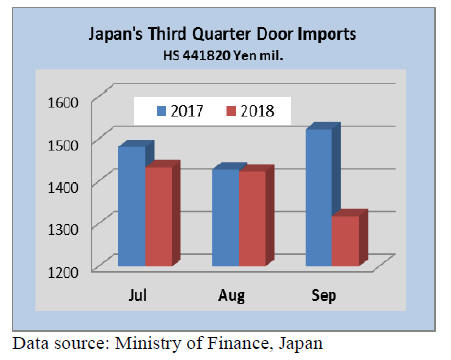
September wooden door imports
Over 90% of September 2018 wooden door imports were
from 4 sources, China (60%) followed by the Philippines
(21%) with Indonesia and Malaysia at 6% each. Other
significant suppliers of wooden doors to Japan in
September were Finland, Canada and the US.
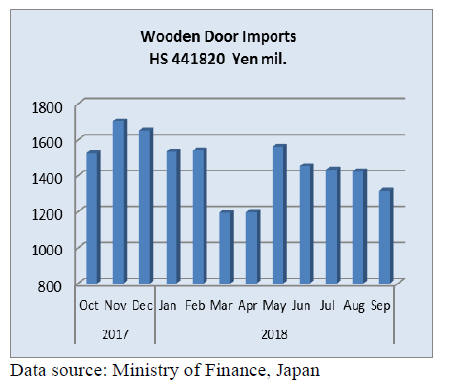
Windows
Third quarter 2018 wooden window imports
Wooden window frames are not widely used in either
domestic or commercial buildings in Japan so import
values are small compared to other joinery products.
In the third quarter of 2018 imports of wooden windows
dropped 18% compared to the third quarter of 2017.
Unlike the import pattern for wooden doors, Japan¡¯s
imports of wooden windows do not exhibit any significant
cyclical trend.
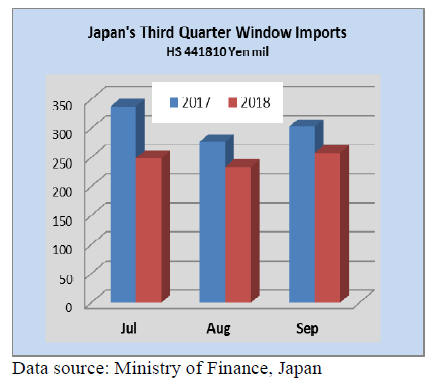
September wooden window imports
September 2018 wooden widow imports were down 15%
year on year but compare to a month earlier, the value of
September imports were up 12%.
In September three suppliers accounted for over 90% of
the value of Japan¡¯s wooden window (HS441810) imports
namely China (37%), the US (35%) and the Philippines
(21%). The value of imports of wooden windows from the
US jumped in September from the 23% import share in
August.
European shippers (natably Finland and Estonia) increased
shipments of wooden windows to Japan in September.

Third quarter 2018 assembled flooring
imports
Most of Japan¡¯s assembled flooring imports are in the
range of HS441871-79. The value of third quarter 2018
imports of these categories of assembled flooring was
around 7% higher than the corresponding quarter in 2017.
In the third quartet imports were dominated by HS441872
which regularly accounts for around 70% of all assembled
flooring imports.
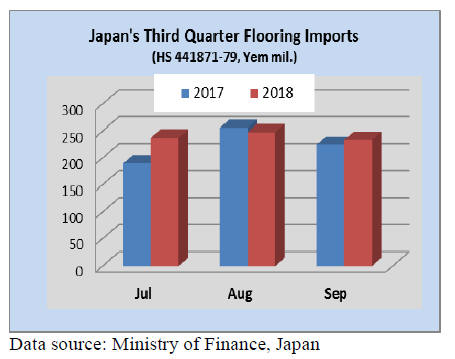
September assembled wooden flooring imports
Year on year the value of September 2018 imports of
assembled wooden flooring were higher by around 4% but
September marked a decline (-6%) in the value of imports
compared to a month earlier.
In September, as in the previous month, HS441875
accounted for over 70% of all assembled wooden flooring
imports with most coming from China followed by
Indonesia, Malaysia and Thailand. HS441873 made up
around 13% of September imports with China being the
main shipper. For HS441879 three shippers, Thailand,
Vietnam and Malaysia accounted for most shipments.
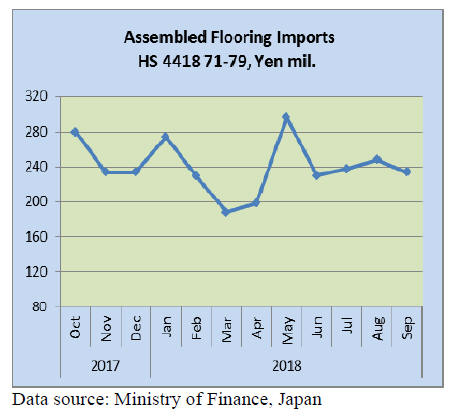
Third quarter 2018 plywood imports
There has been a steady decline in the volume of plywood
imports from Malaysia this year with the steepest fall
beginning in mid-year as the supply of logs to plywood
mills in Sarawak were sharply reduced.
In the third quarter of 2018 total volumes of plywood
imports were down 2% from the same quarter in 2017.
Comparing the third quarter 2017 and 2018 volumes of
imports shipments from China were up 11%, from
Indonesia shipments rose 9% but there was a 16% decline
in shipments from Malaysia. Third quarter 2017 and 2018
import volumes are shown below.
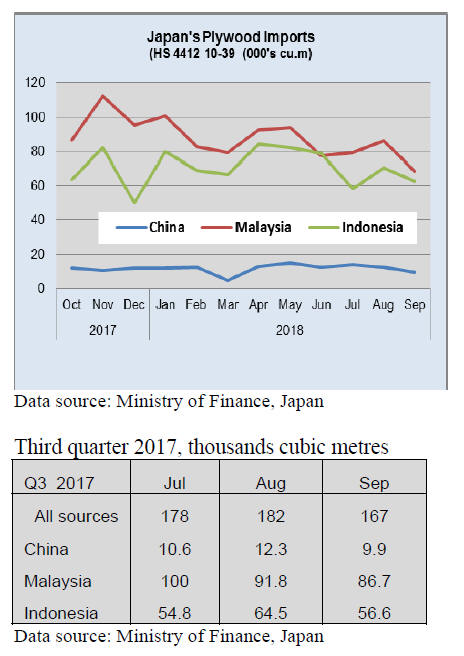 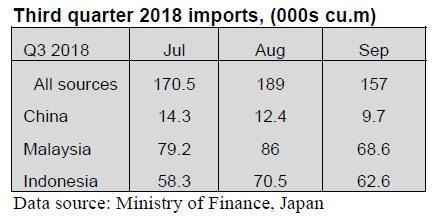
September plywood imports
Year on year September 2018 plywood imports dropped
6%. Shipments from China were at around the same level
as in 2017, arrivals from Indonesia in September were
11% higher but Malaysia saw a 21% decline in year on
year shipments in September.

As in previous months HS441231 is the main category
of
plywood imports into Japan accounting for over 90% of all
arrivals in September 2018. Shipments of HS441231 are
domnated by suppliers in China. It is noteworthy that
plywood manufacturers in Vietnam are capturing a greater
share of the Japanese plywood market.
Trade news from the Japan Lumber Reports (JLR)
The Japan Lumber Reports (JLR), a subscription trade
journal published every two weeks in English, is
generously allowing the ITTO Tropical Timber Market
Report to reproduce news on the Japanese market
precisely as it appears in the JLR.
For the JLR report please see:
http://www.nmokuzai.
com/modules/general/index.php?id=7
South Sea (Tropical) plywood
Log shortage in Malaysia and Indonesia is grave and
plywood mills struggle to keep the operation.
Korindo in Indonesia stooped the operation then Sinora
Sdn Bhd in Sabah, Malaysia stopped the operation by log
supply shortage.
Korindo is the only supplier of concrete forming panel for
Japan with monthly volume of 7,000 cbms from two
plants.
One of two mills, KAS stopped the operation so that the
supply volume for Japan will be half. . Both Malaysia and
Indonesia, log supply got tight since summer of 2017 then
after rainy season arrived in late 2017, log inventories of
plywood mills dried up, which when Korindo shutdown.
Log supply did not recover even in summer of 2018.
In Sabah, Malaysia, log export was banned in May this
year so plywood mills were expected to have more logs
but because of restriction of illegal logging by the
government, log supply continued tight and Sinora had to
shut down.
Sinora had been supplying about 4,000 cbms of 12 mm
structural and concrete forming panel a month. Reason of
log supply shortage is not only by weather but tighter
restrictions of harvest control by the government. Plywood
manufacturers in both Malaysia and Indonesia offer much
higher export prices because of high log cost, which
discourages overseas buyers so mills¡¯ operation is slower,
which deteriorates mills¡¯ profitability.
In Japan, imported cost of JAS 3x6 coated concrete
forming panel prices are over 1,600 yen per sheet FOB
truck with exchange rate of 113 yen per dollar but the
market prices are about 1,500 yen.
Korindo is cornered
Korindo, plywood mill in Indonesia is in tough shape with
operational loss for three consecutive terms. It stopped the
operation of KAS plant on October 23. High log cost and
low sales prices put all the plywood mills in Malaysia and
Indonesia in life or death situation.
Korindo has been supplying about 10,000 cbms of
concrete forming panel for Japan a month. By KAS plant
shutdown, the volume is reduced to half. . Korindo
shutdown in late 2017 and early 2018 by log supply
shortage but to continue payment of wage for the workers,
it restarted the operation despite unprofitable operation.
Since then log prices have been climbing and after loss for
three terms became definite, it decided to stop KAS
operation. By operating only one plant, necessary log
volume will be less and loss will be half.
Korindo has been buying small low grade logs for
manufacturing concrete forming panel but availability of
low cost low grade logs is getting tight because the
government restricts clear logging to develop palm farm
and selective harvest makes it hard to buy logs under 60
cm in diameter.
Another blow for Korindo is decreased sales to the Middle
East market. Korindo¡¯s coated concrete forming panel is
higher than others in price but the quality was good so it
had good reputation but continuous price hike sent buyers
to low cost Russian and Chinese products.
Wage payment problem is not solved but definite
condition of restart is profit making. For that, cost
reduction or higher sales prices are necessary but there is
slim chance that log prices would be down and further
hike of sales prices are also difficult.
Plywood
September production of softwood plywood was 252,300
cbms, 4.0% less than September last year and 0.1% more
than August. In this, structural panel was 236,100 cbms,
6.9% less.
The shipment of softwood plywood was 241,500 cbms,
9.7% less and 0.3% more. With the production exceeding
the production, the inventory increased by 12,300 cbms to
196,800 cbms.
The inventory of structural panel was 171,400 cbms,
14,400 cbms more. The movement of softwood plywood
for precutting plants hit the bottom in September and is
recovering in October.
In Western Japan, rehabilitation works for the area, where
abnormal heavy rain in July and passing typhoons in
September one after another, is getting busy and
transportation of materials is active so that securing truck
becomes difficult so delivery of plywood is delayed for a
week or so. The movement in distribution channels
continues dull.
In September, due to mid-term book closing month, some
disposed of the inventories so that the low price offers
were around and the market turned to bearish and buyers
tightened purchase but such mood disappeared in October.
Market of imported plywood continues stagnant. Despite
announcement of Korindo¡¯s mill closure, there is no panic
buying due to weak demand but the market prices are
generally moving up because the cost of arrived cargoes is
much higher. The importers try to push the sales prices
seriously now.
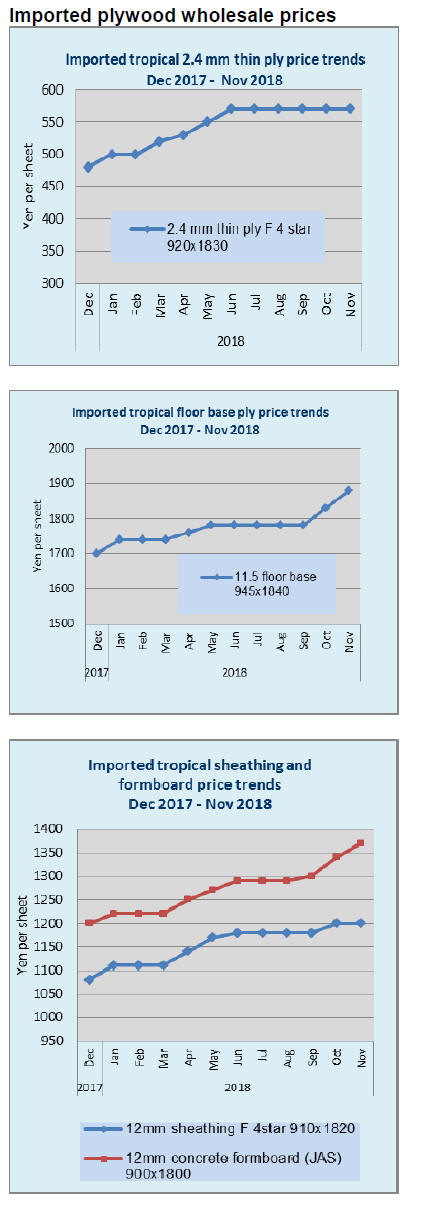
Panel market in Hokkaido
Since last August, supply of imported concrete forming
panel in Hokkaido became tight because Malaysian
plywood mills¡¯ production is dropping by log supply
shortage and shipment to Hokkaido is limited.
Concrete forming panel market in Hokkaido is different
from the main island of Japan, where coated concrete
forming panel is now the main item.
In Hokkaido, green concrete forming panel is the main
item so the prices of JAS 3x6 are slightly higher than
Tokyo market at 1,380-1,400 yen per sheet FOB truck and
firming. Coated concrete forming panel prices are also
higher than Tokyo market at about 1,550 yen.
September earthquake was limited in the area so there is
not much rehabilitation works. While general construction
market in Hokkaido is quiet, shortage of only concrete
forming panel is the topic in the market.
Since middle of 2017, log production in Malaysia sharply
dropped. Green concrete forming panel needs smooth
surface to some extent and with limited log supply, such
suitable logs are hard to obtain.
In Hokkaido, OSB is heavily used for panel for housing.
Canadian OSB manufacturer, Norbord has been pushing
OSB prices and present prices the importers are asking on
JAS 9 mm 3x10 are 1,200 yen per sheet FOB truck.
Softwood plywood is not popular and only manufacturer,
Marutama, is basically sending the products to Tokyo
market. The prices of 12 mm 3x6 panel are firmly held at
1,050 yen per sheet delivered in Hokkaido.
Domestic log and lumber market
It is log harvest season now but log production stays low.
Particularly in Western Japan, where suffered heavy rain
and landslides during summer months, log production has
been low. In other areas, weather after September has been
unfavorable so overall log production continues low.
Meantime demand for logs by sawmills, plywood mills
and laminated lumber mills is active so log supply for
these mills stays tight. Normally June and July are rainy
season so that log production is low but even in fall, there
is no recovery.
In this situation, log market prices have been edging up
everywhere.3 meter post cutting cedar log prices are
12,000-13,000 yen in average but they are higher in the
area where many sawmills concentrate like Northern
Kanto.
4 meter sill cutting cypress log prices vary by the area but
average prices are 19,000-20,000 yen and the highest is
22,000 yen. 3 meter post cutting cypress log prices are
almost the same as sill logs but in other areas, the prices
are 16,000-17,000 yen so gap between sill logs and post
logs is widening.
Meantime, lumber market is not so active. Lumber market
prices remain unchanged although sawmills try to push the
sales price up because of higher log cost.
Nationwide average prices of 3 meter KD 105 mm cedar
post are 50,000-52,000 yen and 4 meter KD 105 mm
cypress sill square are 64,000-66,000 yen. Orders for KD
cedar post, purlin, green cedar 90 mm square and retaining
board are active. KD cedar post movement is slowing in
October while cypress sill continues firm. The most
demanded item is 4 meter green cedar 90 mm square.
In Tokyo regional market, supply of green cedar lumber
has been tight since last spring. Supply source
is mainly the North East sawmills and the supply is always
slow in winter because of snow but this supply did not
increase even after spring this year. Prices of 4 meter 90
mm green cedar lumber had been 20,000 yen or less until
last year but the prices escalated over 20,000 yen and now
they are 25,000 yen to 28,000 yen and the highest spot prices
are30,000 yen.
Reason of tight supply is expanding demand. 4 meter
green cedar 90 mm square is mainly used for not only
construction but rehabilitation works by natural disasters
then increasing redevelopment demand for the 2020¡¯s
Tokyo Olympic Games.
Substituting demand for roof sheathing to replace high
priced softwood plywood is also another new demand.
Sawmills suffer high log prices and say that it is hard to
procure logs when lumber prices are less than 30,000 yen.
In Kanto region, there are very few mills producing green
cedar lumber because small cedar log supply is not much
in this region. The log prices started climbing since last
December and they are high at 10,000-12,000 yen, which
is too high for lumber prices so mills are not willing to
produce.
|